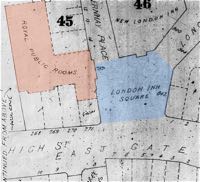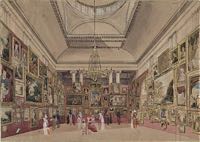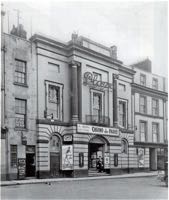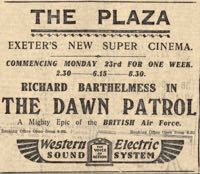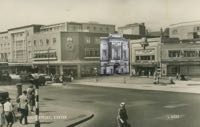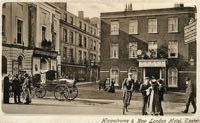
The Royal Public Subscription Rooms
Later the Hippodrome and then the Plaza Cinema
Page updated 24th November 2015
Royal Public Subscription Rooms
If you ever shop in Boots, in the High Street, and enter the store through the corner entrance, you will be crossing the site of the Royal Public Rooms, a one-time ballroom, theatre and cinema.
The first Assembly Rooms in Exeter were built by William Mackworth Praed in 1769 in Cathedral Yard - within a year the new building became the Hotel, or as we know it now, the Royal Clarence Hotel.
On 17th October 1820, the purpose built Royal Public Rooms were opened, for a musical festival, at the bottom of Northernhay Place, adjacent to the New London Inn in New London Square. The site on which the rooms were constructed had previously been three tenements and the Bristol Inn, all of which were in poor condition. In 1874, a memory appeared in the Flying Post. "Before the Subscription Rooms were built stood the old Bristol Inn, with two entrances; one in the London-inn-square, wide enough for coaches to enter, the other in the High-street."
The new building, financed by public subscription was constructed for Miss Congdon. It had a ball room measuring 92 ft by 41 ft and 40 ft high, and could accommodate 700 people, to provide a public space for concerts, balls, exhibitions and other events. It also had a tearoom and separate exhibition rooms. The London Inn Square facade was 44 ft wide. William Burgess, designed the new Public Subscription Rooms. A local man he had recently remodelled St Sidwell's Church.
WIthin a short time the Rooms had hosted a grand dinner for the celebration of the coronation of George IV in July 1821, and had taken on the annual Assize Ball, one of the high points for the fashionable. Sedan chairs would wait outside for parties attending concerts and balls.
In 1823, the first hackney carriages were introduced by Humphrey Stark, who obviously found London Inn Square would provide plenty of custom from the Subscription Rooms and the New London Inn.
Jenny Lind, the Swedish Nightingale gave two concerts, one at 8pm and the second at 2am, at the Royal Public Rooms in 1847 – 1,600 paid 10/6, 15s and 1 guinea to see her perform with the gross receipts of £1,280. It was estimated that she was paid £800 for the two concerts. In 1878 Thomas Gardner was the lessee and in 1897 it was William Edwards.
First Film Show - 1907
The Royal Public Rooms became the venue for a film show in February 1907 with a lecture incorporating film about the life of trawler fishermen.
The Hippodrome Theatre and Living Pictures
By 1908 the building was taken over by Fred Karno who commissioned the architect Kendall to convert it into an Edwardian music hall, named the Hippodrome. It was opened on 2 November 1908.
The main auditorium could seat 700 with a balcony and gallery seating a further 380. Charlie Chaplin is said to have appeared there, in the infamous sketch, the "Mumming Birds", before he went of Hollywood. It was also used as an early cinema, giving Chaplin the chance to return, but this time on celluloid. Marie Lloyd and Harry Tate were two others who trod the Hippodromes boards.
The first night performance "...opened to overflowing houses with a variety programme that won general applause from all parts of the house." The programme included the "...drawing-room performance of the Dandies to the neat acrobatics of Archie Rogers, the comedy items of Ivy Proudfoot, Lenton and Lane, Bert Terrell, and Jack Pleasants, the clever burlesque of Rubart, and the eccentricities of old friend Rabbit, with a capital lot of living pictures at the finish."
There was a specially printed silk covered programme for the opening show. As the programme of events shows, 'living pictures' were shown at the end of each performance. An advert for the first night stated "HIPPODROME PICTURES Showing all the Latest up-to-date Events.' The Hippodrome was not the first to show moving pictures in Exeter - the Victoria Hall had shown its first film as early as 1896.
Before the advent of television documentaries, spectaculars were staged that told the story of recent and historic events. In November 1912, the Hippodrome staged a re-enactment, by Charles and John Poole, of the sinking of the Titanic. The story from the departure at Southampton, to the collision with the iceberg and the sinking was presented as a series of eight tableaux - 'Unique mechanical and electrical affects, special music and the story was described in a thrilling manner'.
One manager, Mr Frank Williams, related when the Hippodrome closed:
"Variety is supposed to have died out during the last ten years, but the audiences to see Will Fyffe and others spoke for themselves. We never relied wholly on the 'star,' but always had a good supporting programme. Artistes looked forward to coming to the old Hippodrome and many will miss it, especially in the summer time. There were sometimes as many as 50 artistes on the bill, and that meant quite a lot business to the city, especially for apartment landladies. Many have told me that it is great pity there should be no music hall in a city like this. Films are, of course, much cheaper than a company of artistes, but I am sure that the public taste for variety is not dead."
There was much hardship during the general strike, but the Hippodrome carried on. Artistes travelled by road. The Exeter Hippodrome had always been handicapped by a lack of capital, which prevented very necessary renovations. Mr Williams regretted the the Hippodrome's orchestra would not find work, as the 'talkies' would no longer require live music. Mr Williams also said:
"Had it been properly financed and put on a firm basis, I think it would have flourished for years."
He was an old variety man, and could not see the changes coming to popular entertainment. In 1925, the Hippodrome was purchased by a Mr Percy Adams, the existing lessee, from the Exeter Municipal General Charities Trust - and it was the challenge of the cinema, and the introduction of the talkies that forced the Hippodrome to close.
The Plaza Cinema
The Hippodrome, both with live shows and cinema, competed with the Theatre Royal, just a few dozen yards away, on the other side of New London Square. Percy Adams sold the Hippodrome in 1929 to Mr Vickery, from Taunton, who closed it and engaged architects, Messrs Lucas and Langfords of Exeter, to redesign the theatre into a cinema. Messrs R C Lee and Co Ltd undertook the renovation, which included a gold proscenium arch around the screen. To achieve the reconstruction in six weeks, shifts of men worked day and night, to meet the deadline. The new cinema was described in the Gazette thus:
"The stage furnishings, supplied by the Walter Law Cinematograph Company, London, are most artistic. A novel adornment has been designed by Mr. Langford for the proscenium arch. It consists of two realistic fountains, made of opaque glass, fitted with revolving lights, which give the effect of falling water. There are also coloured lights, which impart a very beautiful effect. The hall has been completely furnished with nearly 1,000 comfortable tip-up bucket seats. The old exits have been effaced, and new ones constructed at more convenient places of reinforced concrete. Mr. Charles Lye, the electrical engineer, of Northernhay-place, can be congratulated on achieving a wonderful combination of colour in his lighting scheme. The great pink-tinted glass lanterns suspended from the ceiling form an important part of the decorations. His large orange coloured chandeliers in the entrance hall and on the staircase are also things of beauty. Electrical apparatus elsewhere has been overhauled, and the whole building re-wired. An ingenious feature is the Plenum system of ventilation, which, with the heating system, has been installed by the Exeter Gas Company. Air is drawn in through the induct, washed over water, rendered warm or cold to any degree in ovens, and then forced into the main ducts, which convey it to the hall. The cycle is completed by a five-horse power fan in the roof, which takes the stale air out. Red emergency lamps glow along the walls. Attention has also been given to the roof, which has been reinforced with steel girders. The entrance hall has been enlarged, and makes a fitting entry to the new hall. A wide staircase leads to the balcony. Good reproduction is assured, new projectors and Western Electric Sound apparatus have been fitted, the generators having been provided by Messrs. Newton, of Taunton."
On 6th February 1931, the Hippodrome, now named the Plaza Cinema opened its 875 seats as a talkie cinema, with Mr Lattimer as the manager. "The King of Jazz" which featured a young Bing Crosby and utilised the recently developed 2 strip Technicolor system was the first film to show at the Plaza. The second feature was the P G Wodehouse musical, Sally which was shot in black and white also with a Technicolor sequence.
By 1935 the manager was A G Firebrace. In 1936, the rival Savoy was built to replace the New London Inn, giving Exonians two cinemas within yards of each other.
A sheet of flame
There was a Devon Farmers meeting, at the Plaza, on the 31 April 1942, four days before the worst blitz to hit Exeter. The Rt. Hon. George Lambert MP spoke of the danger still facing the country and that the farmers had to produce food, as vital supplies were being lost to U-boats. He went on:
"Who can tell what sort of a world it is going to be when the war is over? One person has come out with a plan for the nationalisation of the land. Let us win the war first. Let us be a little more humble. l am confident that we shall win the war, but a little more humility will do us no harm."
The last film to be scheduled for the Plaza was ironically "The Hurricane" which was described:
"EXETER CINEMAS Plaza. Film version of a famous novel The Hurricane," comes to the Plaza for the first half of next week. The climax is the amazing spectacle which gives the story its name..."
This grand old building would not survive the blitz of 4 May 1942 and a hit from a single high explosive bomb destroyed it and created a conflagration in the buildings all around.
"The damage to this particular business premises group appears to have been caused by a bomb which fell on the Plaza Cinema almost entirely demolishing the building. This building was a converted theatre of the old type and a very bad fire risk; the explosion caused a sheet of flame which seemed to envelop the premises immediately. The wind, being in a north-easterly direction, fanned the flames on to the adjoining premises, spreading rapidly, the fire guards on duty found it impossible to cope with the resulting fire. The roofs of the premises involved were of such a nature that access was difficult and whilst the number of incendiary bombs which actually fell on the block was small, all the premises were destroyed from the fire originating at the Plaza Cinema."
Neither of the Plaza's nearest rivals, the Savoy/ABC, and the Theatre Royal survived the 20th-century, leaving this part of Exeter to the serial shopper.
Sources: Exeter Flying Post, Western Times, Exeter and Plymouth Gazette, Report on the Damage Caused by Fire and Fire Bombs at Exeter by the Raid on Monday the 4th May 1942.
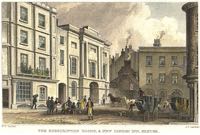
A print showing the Royal Public Subscription Rooms (centre left), the New London Inn (right) and London Inn Square.
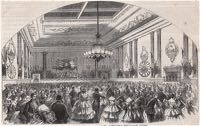
A dinner of the 9th Lancers in the ball-room. Compared to the image, right, there is some artistic licence in this engraving from the 1860 Illustrated London News.
│ Top of Page │


